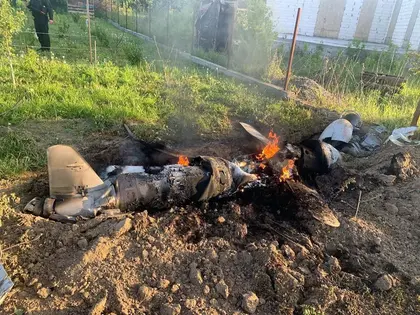Attempting to throw off Ukrainian intelligence estimates of the Kremlin’s remaining stockpile of weapons, Russia has changed its serial number system to prevent accurate analysis using missile debris.
JOIN US ON TELEGRAM
Follow our coverage of the war on the @Kyivpost_official.
Wreckage from a Kh-101 shot down over Kyiv on Wednesday morning has numbers that no longer give away the production date, according to Defense Express.
Under previous conventions, the production quarter and year were part of the serial number, but debris from the Kh-101 would have been made in the eighth quarter of 2018, an obvious impossibility.
- See the newest war in ukraine update from the Kyiv Post's news bulletins published today.
- Examine the most contemporary Ukraine news that came out today.
“It’s probable the Kremlin intends to mask missile production numbers [and prevent drawing] conclusions from the debris,” wrote Defense Express.
This new wrinkle comes as Kyiv fears the possibility of Moscow's increased production while saving weapons in recent months, in potential preparation for a barrage of attacks on cities and infrastructure during the cold winter season.
The early morning attack yielding this new information came during the first few hours of Aug. 30, when a couple of dozen missiles were fired at the capital.
City administration officials described the nighttime attack on Kyiv as “the most powerful assault since the spring.”
The attack, a large-scale and coordinated effort involving drones and missiles, led to the release of debris from the rockets, resulting in the deaths of two individuals and injury to another within the Shevchenkivskyi district. The deceased, aged 26 and 36, served as security guards at the affected enterprise.

$4.5M Russian An-72 Aircraft Destroyed Near Moscow, Ukrainian Intel Reports
Additionally, the impact of the descending rocket components triggered destruction and fires across the Shevchenkivskyi and Darnytskyi districts.
In a previous statement, Major General Vadym Skibitsky, a representative of the Main Directorate of Intelligence (HUR) under the Ministry of Defense, said that Russian forces currently have a minimum of 585 missiles (excluding the Kh-22) with the capability to strike distances exceeding 500 kilometers.
Skibitsky said that, contrary to Ukrainian expectations, Russia has not only stockpiled missiles since the onset of spring but has also escalated its production.
Aside from the 6 Kinzhal missiles, Russia’s strategic plans include the production of 30 Iskander-M ballistic missiles, 12 Iskander-K cruise missiles, 20 Kalibr missiles, and approximately 40 Kh-101 missiles for the month of August, according to Skibitsky.
Russia is also enhancing Kh-22 cruise missiles, introducing modified versions reclassified as Kh-32s. According to HUR reports, the Russians can only deliver up to 10 units of these upgraded missiles each month.
You can also highlight the text and press Ctrl + Enter






